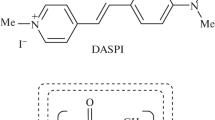Abstract
Host–guest inclusion type association between native β-cyclodextrin and randomly substituted methyl-β-CD and two 2-styrylindolium cationic dyes, e.g. 1,3,3-trimethyl-2-(4-diethylaminostyryl)-3H-indolium iodide (D1) and 1,3,3-trimethyl-2-[4-(N-2-cyanoethyl,N-methyl)-aminostyryl]-3H-indolium iodide (D2), are reported. The described indolium derivatives belong to the rarely investigated class of unsymmetrical polymethines. The complex formation was studied in aqueous buffer solutions with two pH values (7.2 and 3) by means of absorption and steady-state fluorescence spectroscopy. The association equilibrium constant (K), the molar absorptivity and the stoichiometry of the complexes were evaluated using the modified Benesi-Hildebrand approach. The complex stability was affected by the pH of the solution and by the type of CD. The results obtained indicate that D1 forms 1:1 complexes with both β-CD and Me-O-β-CD, whereas D2 does not form stable complexes with Me-O-β-CD and in acidic medium. The fluorescent intensity of D1 in the presence of CDs increases over four times relative to the intensity of the pure dye solutions, presumably via inclusion of the dye into the cyclodextrin cavity due to rigidity of the structure.








Similar content being viewed by others
References
Connors, K.A.: The stability of cyclodextrin complexes in solution. Chem. Rev. 97, 1325–1357 (1997).
Liu, L., Guo, Q.X.: The driving forces in the inclusion complexation of cyclodextrins. J. Incl. Phenom. Mac. Chem. 42, 1–14 (2002).
Coly, A., Aaron, J.J.: Cyclodextrin-enhanced fluorescence and photochemically-induced fluorescence determination of five aromatic pesticides in water. Anal. Chim. Acta 360, 129–141 (1998).
Maafi, M., Laassis, B., Aaron, J.J., Mahedero, M.C., Munoz de la Pena, A., Salinas, F.: Photochemically induced fluorescence investigation of a β-cyclodextrin: Azure A inclusion complex and determination of analytical parameters. J. Incl. Phenom. Mol. Recogn. Chem. 22, 235–247 (1995).
Gonzalez, M.A., Lopez, M.H.: Determination of fluorene in sea-water by room temperature phosphorescence in organised media. Analyst 123, 2217–2221 (1998).
Scypinski, S., Cline Love, L.J.: Room-temperature phosphorescence of polynuclear aromatic hydrocarbons in cyclodextrins. Anal. Chem. 56, 322–327 (1984).
Duveneck, G.L., Sitzmann, E.V., Eisenthal, K.B., Turro, N.J.: Picosecond laser studies on photochemical reactions in restricted environments: the photoisomerization of trans-stfibene complexed to cyciodextrins. J. Phys. Chem. 93, 7166 (1989).
Patonay, G., Salon, J., Sowell, J., Strekowski, L.: Noncovalent labeling of biomolecules with red and near-infrared dyes. Molecules 9, 40–49 (2004).
Deligeorgiev, T.G., Zaneva, D.A., Kim, S.H., Sabnis, R.W.: Preparation of monomethine cyanine dyes for nucleic acid detection. Dyes and Pigments 37, 205–211 (1998).
Ohashi, M., Kasatani, K., Shinohara, H., Sato, H.: Molecular mechanics studies on inclusion compounds of cyanine dye monomers and dimers in cyclodextrin cavities. J. Am. Chem. Soc. 112, 5824–5830 (1990).
Kasatani, K., Ohashi, M., Kawazaki, M., Sato, H.: Cyanine dye-cyclodextrin systems. Enhanced dimerization of the dye. Chem. Lett. 1633–1636 (1987).
Matsuzawa, Y., Tamura, S., Matsuzawa, N., Ata, M.: Light stability of a β-cyclodextrin inclusion complex of a cyanine dye. J. Chem. Soc. Faraday Trans. 90(23), 3517–3520 (1994).
Mitewa, M., Mateeva, N., Antonov, L.: Spectrophotometric investigation on the complexation between chromo- and flouroionophores containing aza-15crown-5 moiety and alkaline and alkaline-earth metal ions. Quim Analitica 16, 153–162 (1997).
Gromov, S.P., Fedorova, O.A., Alfimov, M.V., Druzhinin, S.I., Rusalov, M.V., Uzhinov, B.M.: Crown-containing styryl dyes. 14. Synthesis, luminescence, and complexation of the trans-isomers of chromogenic 15-crown-5-ethers. Izv. Akad. Nauk., Ser. Khim. 10, 2003–2008 (1995).
Nishida, M., Ishii, D., Yoshida, I., Shinkai, S.: Molecular association of water-soluble calixarenes with several stilbene dyes and its application to the facile determination of cationic surfactant concentrations. Bull. Chem. Soc. Jpn. 70, 2131–2140 (1997).
Metsov, S., Dudev, T., Koleva, V.: Infrared and NMR study of some 2-styrylindolium dyes. J. Mol. Str. 350, 241–246 (1995).
Kiprianov, Al., Ushenko, I.K.: Colour of the organic dyes and its plane geometry. Zh. Obshch. Khim. 20, 514, (1950).
Brooker, L.G.S.: Absorption and resonance in dyes. Rev. Mod. Phys. 14, 275–293 (1942).
Suzuki, H.: Electronic Absorption Spectra, Geometry of Organic Molecules. Academic Press, New York (1967), pp. 367.
Benesi, H.A., Hildebrand, J.H.: A spectrophotometric investigation of the interaction of iodine with aromatic hydrocarbons. J. Am. Chem. Soc. 71, 2703–2707 (1949).
Yoshida, N., Fujita, Y.: Dynamic aspects in host-guest interactions. 3. Kinetics and mechanism for molecular recognition by hexakis(2,6-di-o-methyl)-α-cyclodextrin of some azo guest molecules. J. Phys. Chem. 99, 3671–3677 (1995).
Sueishi, Y., Hishikawa, H.: Complexation of 4-dimethylaminoazobenzene with various kinds of cyclodextrins: effects of cyclodextrins on the thermal cis-to-trans isomerization. Int. J. Chem. Kin. 34, 481–487 (2002).
Acknowledgement
Financial support from the National Science Foundation—Bulgaria is gratefully acknowledged.
Author information
Authors and Affiliations
Corresponding author
Rights and permissions
About this article
Cite this article
Petinova, A., Metsov, S., Petkov, I. et al. Photophysical behaviours of some 2-styrylindolium dyes in aqueous solutions and in the presence of cyclodextrins. J Incl Phenom Macrocycl Chem 59, 183–190 (2007). https://doi.org/10.1007/s10847-007-9313-4
Received:
Accepted:
Published:
Issue Date:
DOI: https://doi.org/10.1007/s10847-007-9313-4



